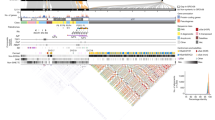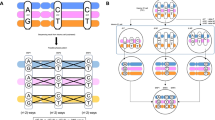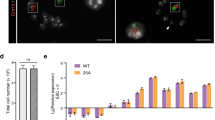Abstract
Human–mouse somatic cell hybrids have proved invaluable in assigning human genes to their respective human chromosomes1. To date, the success of this approach has depended on identifying human proteins which are synthesised in hybrid cells containing a small number of human chromosomes. Consequently, chromosome assignment has been limited mainly to human proteins which are expressed in man–mouse somatic cell hybrids and for which a suitable assay, usually electrophoretic or immunological, exists to distinguish between the human and murine homologous proteins. This technique is therefore unsuitable for the assignment of those human genes which are expressed only in differentiated cells and not in hybrid cells. Here, we describe how nucleic acid hybridisation and restriction endonuclease mapping of DNA can be combined to test for the presence of human structural gene sequences within hybrid cell DNA. This method can be used to assign any purified human DNA sequence to a human chromosome, and does not require the DNA sequence to be expressed in man–mouse hybrid cells.
This is a preview of subscription content, access via your institution
Access options
Subscribe to this journal
Receive 51 print issues and online access
$199.00 per year
only $3.90 per issue
Buy this article
- Purchase on Springer Link
- Instant access to full article PDF
Prices may be subject to local taxes which are calculated during checkout
Similar content being viewed by others
References
Ruddle, F. H. & Creagan, R. P. A. Rev. Genet. 9, 407–486 (1975).
Southern, E. M. J. molec. Biol. 98, 503–517 (1975).
Little, P. et al. Nature 273, 640–643 (1978).
Flavell, R. A., Kooter, J. M., de Boer, E., Little, P. F. R. & Williamson, R. Cell 15, 25–41 (1978).
Little, P. F. R., Flavell, R. A., Kooter, J. M., Annison, G. & Williamson, R. Nature 278, 227–231 (1979).
Jeffreys, A. J. Cell 18, 1–10 (1979).
Deisseroth, A. et al. Proc. natn. Acad. Sci. U.S.A. 75, 1456–1460 (1978).
Buck, D. W., Bodmer, W. F., Bobrow, M. & Francke, U. Birth Defects 12, 97–98 (1976).
Francke, U. & Busby, N. Birth Defects 11, 143–149 (1975).
Boone, C., Chen, T. R. & Ruddle, F. H. Proc. natn. Acad. Sci. U.S.A. 69, 510–514 (1972).
Lawn, R. M., Fritsch, E. F., Parker, R. C., Blake, G. & Maniatis, T. Cell 15, 1157–1174 (1978).
Meera Khan, P. Archs biochem. biophys. 145, 470–483 (1971).
Jeffreys, A. J. & Flavell, R. A. Cell 12, 1097–1108 (1977).
Author information
Authors and Affiliations
Rights and permissions
About this article
Cite this article
Jeffreys, A., Craig, I. & Francke, U. Localisation of the Gγ-, Aγ-, δ- and β-globin genes on the short arm of human chromosome 11. Nature 281, 606–608 (1979). https://doi.org/10.1038/281606a0
Received:
Accepted:
Published:
Issue Date:
DOI: https://doi.org/10.1038/281606a0
This article is cited by
-
The molecular basis of thalassemias
The Indian Journal of Pediatrics (1989)
-
Hypervariable telomeric sequences from the human sex chromosomes are pseudoautosomal
Nature (1985)
-
Rapid and quantitative detection of unique sequence donor DNA in extracts of cultured mammalian cells: An aid to chromosome mapping
Somatic Cell and Molecular Genetics (1985)
-
Human parathyroid hormone gene (PTH) is on short arm of chromosome 11
Somatic Cell Genetics (1983)
-
Assignment of the human coproporphyrinogen oxidase to chromosome 9
Human Genetics (1983)
Comments
By submitting a comment you agree to abide by our Terms and Community Guidelines. If you find something abusive or that does not comply with our terms or guidelines please flag it as inappropriate.



